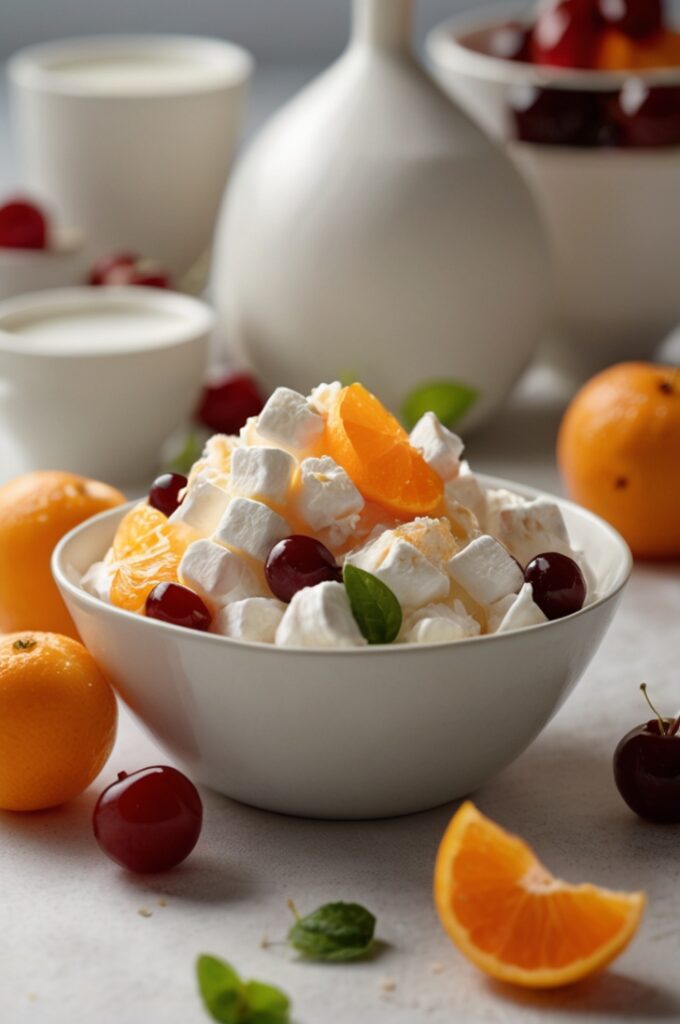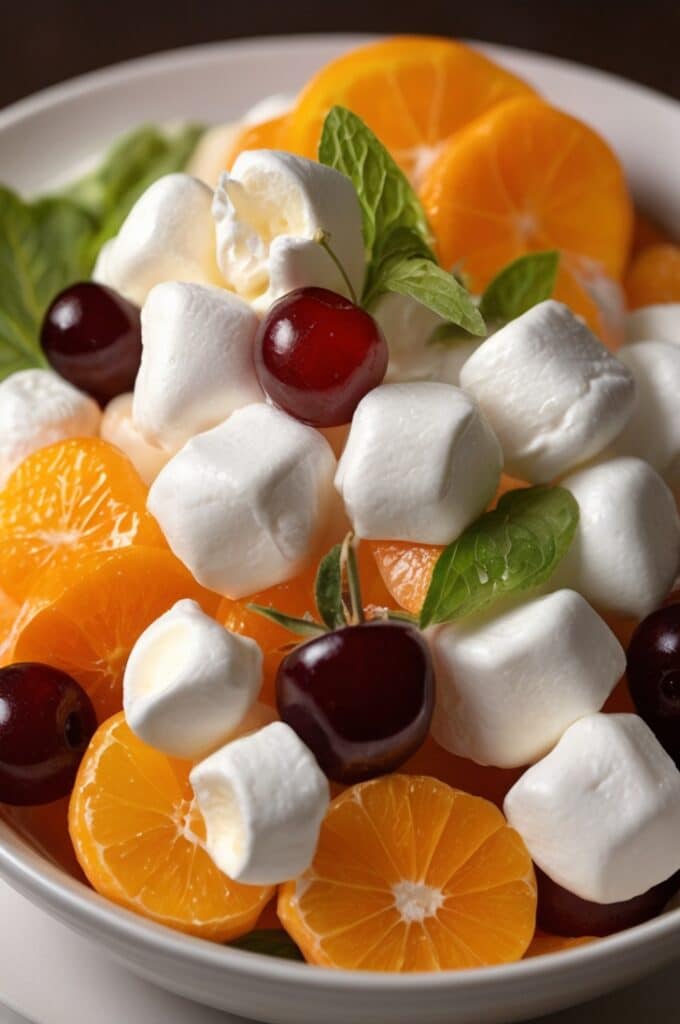I still remember the first time I encountered ambrosia salad at my grandmother’s Sunday dinner table. The cloud-like texture cradled between spoonfuls of pineapple and mandarin oranges created such a lasting impression that I’ve been perfecting my own version for over two decades. This nostalgic American classic has persisted through changing culinary trends for good reason it’s simply irrestible.
Ambrosia, litterally meaning “food of the gods” in Greek mythology, is aptly named. This dreamy concoction marries the pillowy softness of marshmallows with juicy fruits, creating a symphony of textures and flavors that dance across the palate. It’s simultaneously retro and timeless, a culinary contradiction that continues to delight generations of eaters.
But what makes a truly exceptional ambrosia salad? As someone who’s prepared this dish professionally for countless gatherings and studied its regional variations extensively, I’ve uncovered the secrets that transform this humble side dish into something truly divine. Whether you’re rediscovering a childhood favorite or experiencing it for the first time, let’s explore the definitive guide to creating the perfect ambrosia salad.
The Origins and Evolution of Ambrosia Salad
Ambrosia’s roots trace back to the late 19th century, when exotic citrus fruits became more widely available in America. Early versions were simple—just oranges, sugar, and coconut. The marshmallow component wasn’t added until the 1920s, when commercially manufactured marshmallows became readily available.
Southern households particularly embraced ambrosia, making it a Christmas and special occasion staple. The dish reflected prosperity and hospitality, as tropical ingredients like coconut and citrus were once considered luxuries. This salad has always been bout celebration and abundance.
Regional variations emerged over decades. Some families insist on sour cream while others are devoted to Cool Whip. The great marshmallow debate—colored or white, mini or standard—continues to this day. I’ve even encountered heated arguments about whether nuts belong in proper ambrosia! These passionate opinions speak to how deeply this dish is embedded in American food culture.
The Perfect Balance: Core Ingredients
The magic of ambrosia lies in achieving perfect harmony between sweetness, tanginess, and textural contrast. Here’s what you’ll need for my signature version:
- 2 cups mini marshmallows (white preferred for traditional appearance)
- 1 cup heavy whipping cream, whipped to soft peaks
- ½ cup sour cream (adds crucial tanginess)
- 2 tablespoons powdered sugar
- 1 teaspoon pure vanilla extract
- 1 can (20 oz) pineapple chunks, well-drained
- 1 can (15 oz) mandarin orange segments, well-drained
- 1 cup seedless grapes, halved (red adds beautiful color)
- 1 cup strawberries, quartered (a non-traditional addition I swear by)
- 1 cup sweetened flaked coconut
- ½ cup chopped pecans or walnuts (optional but recommended)
- 2 tablespoons maraschino cherries, halved (primarily for color)
The key to success is the balance of cream components. Too much sweetened whipped cream produces a cloying dessert; too much sour cream creates tang that overwhelmes the fruits. My ratio achieves the perfect middle ground, letting the natural sweetness of the fruits shine while maintaining that characteristic creamy dreaminess.
Ingredient Selection: The Details Matter
Choosing the right ingredients makes all the difference in elevating your ambrosia from good to extraordinary. For marshmallows, mini varieties distribute more evenly throughout the mixture. While colored marshmallows can be festive for holidays, they sometimes contain artificial flavors that compete with the fruits.

Fresh vs. canned fruit represents another crucial decision. While authenticity calls for canned fruits (particularly mandarin oranges, which are difficult to segment freshly), I recommend a hybrid approach. Canned pineapple and mandarins provide consistent sweetness and convenience, while fresh strawberries and grapes contribute brightness and textural integrity that canned versions simply can’t match.
The coconut question deserves special attention. Sweetened flaked coconut provides the traditional flavor profile, but freshly grated coconut offers a more sophisticated experience. If using fresh, consider toasting half of it to develop nuttier flavor notes and added textural complexity.
The Method: Crafting Perfect Ambrosia
Creating truly exceptional ambrosia requires more technique than most people realize. Follow these steps for optimal results:
- Prepare fruits the night before, draining canned varieties thoroughly in a colander. Place them on paper towels in the refrigerator overnight to remove excess moisture—skipping this step is the single biggest mistake that leads to watery ambrosia.
- Combine the heavy cream, powdered sugar, and vanilla in a chilled metal bowl. Whip to soft peaks, being careful not to overwhip. The mixture should gently hold its shape while remaining silky.
- In a seperate bowl, stir together the sour cream and whipped cream using a rubber spatula with a gentle folding motion. This creates the perfect creamy base without deflating the whipped cream’s volume.
- Add the well-drained fruits, coconut, and nuts (if using) to the cream mixture. Fold gently rather than stirring to maintain the integrity of the fruits and the airiness of the cream.
- Finally, incorporate the marshmallows with a few final folds. The marshmallows should be the last addition, as they begin absorbing moisture immediately upon contact with the other ingredients.
The timing of assembly represents a crucial consideration. Ambrosia needs at least 2 hours of refrigeration for the flavors to meld properly. However, exceeding 8 hours can result in excessive softening of the marshmallows and fruits. For best results, prepare it in the morning for an evening gathering or the evening before for lunch service.
The Science Behind Perfect Ambrosia
Understanding the science of ambrosia helps explain why certain techniques yield superior results. The marshmallows undergo a fascinating transformation as they absorb moisture from the fruits and cream. This process, essentially a controlled dissolution, creates that characteristic texture where the marshmallows retain their form while adopting a meltingly tender quality.
The high sugar content in both the marshmallows and fruits creates an osmotic effect that draws out moisture over time. This is why ambrosia always tastes better after resting—the flavors literally migrate between components, creating a more cohesive whole.
Acidity plays an essential role as well. The citric acid in the fruits helps balance the sweetness while also providing structural stability to the whipped cream through its interaction with the milk proteins. This contributes to ambrosia’s remarkable stability compared to other whipped cream-based desserts.
Regional and Modern Variations
Traditional ambrosia varies significantly by region, with some fascinating local adaptations:
Southern versions often incorporate pecans and maintain strict adherence to proportions of citrus and coconut. Midwestern interpretations frequently include bananas and sometimes apples. West Coast variations may incorporate kiwi or even mango for a more tropical profile.
Modern culinary trends have spawned contemporary adaptations worth exploring:
- Greek yogurt can replace some or all of the sour cream for a protein boost and probiotic benefits
- Agave nectar sometimes substitutes for powdered sugar in health-conscious versions
- Freeze-dried fruits add concentrated flavor bursts and interesting textural elements
- Coconut cream can replace dairy for vegan interpretations
- Artisanal marshmallows infused with flavors like vanilla bean or orange blossom offer sophisticated complexity
Don’t be afraid to experiment with these variations, but always maintain the fundamental textural contrast between creamy, fluffy, and juicy elements that defines true ambrosia.
Serving and Presentation Ideas
While traditionally served in a large glass bowl to showcase its colorful layers, ambrosia offers numerous creative presentation possibilities. Individual parfait glasses create an elegant dessert course for formal dinners. Mason jars make portable options for picnics or potlucks.
For an interactive experience, consider an ambrosia bar where guests can customize their portions with additional toppings like toasted coconut, chocolate shavings, or candied citrus peel. This approach works beautifully for brunch gatherings or casual entertaining.
Timing matters significantly when serving ambrosia. Remove it from refrigeration about 15 minutes before serving—the flavors bloom more prominently when not ice-cold. A subtle sprinkle of flaked sea salt just before serving provides a contemporary twist that amplifies the sweetness through contrast.
Ambrosia traditionally accompanies ham or other holiday meats, but it pairs beautifully with spicy foods as well. The cooling creaminess balances heat perfectly, making it an unexpected but delightful accompaniment to Caribbean or Southeast Asian cuisines.
Storing and Reviving Ambrosia
Proper storage extends ambrosia’s prime eating window. Always refrigerate in an airtight container to prevent it from absorbing refrigerator odors. Consume within 3 days for optimal texture, as the fruits gradually release more juice and the marshmallows continue softening over time.
If your ambrosia begins weeping excess liquid after storage, don’t discard it! Drain off the excess liquid and refresh the mixture with a few tablespoons of freshly whipped cream folded in gently. Add a handful of fresh mini marshmallows to restore some of the textural contrast.
Freezing ambrosia is generally not recommended, as the thawing process causes significant textural degradation. However, a semi-frozen ambrosia makes a delightful summer treat, similar to a fruity semifreddo. Simply place in the freezer for about an hour before serving on particularly hot days.
The Cultural Significance of Ambrosia
Beyond its delicious taste, ambrosia carries significant cultural weight in American foodways. It represents a distinctly American approach to dessert—unabashedly sweet, somewhat informal, and celebrating abundance through varied ingredients.

The dish appears consistently at potlucks, church suppers, and family gatherings across the country, transcending regional and socioeconomic boundaries. Its presence signals festivity and tradition, especially during holidays when familiar foods create comforting continuity.
Ambrosia also reflects America’s culinary history through its ingredients. The tropical components arrived through trade routes and agricultural expansion, while the marshmallows represent industrial food innovation. Even the name reflects American optimism—claiming divine status for a humble fruit salad shows characteristic cultural confidence.
Conclusion: Why Ambrosia Endures
Ambrosia salad endures in our culinary landscape because it captures something essentially comforting—sweet, creamy, familiar yet special. It bridges generations, appearing on tables decade after decade despite changing food trends.
The best ambrosia balances nostalgia with quality ingredients and thoughtful preparation. By understanding the principles behind this seemingly simple dish—proper drainage, gentle folding, intentional ingredient selection, and appropriate resting time—you can create a version that honors tradition while satisfying contemporary palates.
Whether served as a side dish, dessert, or somewhere deliciously in-between, perfect ambrosia reminds us that sometimes the most unassuming dishes carry the richest memories and greatest pleasure. Food of the gods, indeed.
FAQs About Ambrosia Salad
Can I make ambrosia salad ahead of time?
You can prepare ambrosia up to 24 hours in advance, but it’s best when made 3-6 hours before serving. The marshmallows need time to soften slightly, but left too long they’ll dissolve completely. If making further ahead, consider adding the marshmallows closer to serving time.
Why is my ambrosia watery?
Inadequate draining of canned fruits is usually the culprit. Drain fruits thoroughly, even patting them dry with paper towels. Also, avoid over-whipping the cream, which can cause it to weep liquid during storage.
What’s the difference between ambrosia and fruit salad?
While both contain fruit, ambrosia specifically includes marshmallows and coconut in a creamy base. Traditional fruit salad typically features fresh fruits in their own juices or a light syrup without the creamy component.
Can I make a healthier version of ambrosia?
Absolutely! Try Greek yogurt instead of whipped cream, reduce the marshmallows by half, use unsweetened coconut, and increase the proportion of fresh fruits. While different from traditional ambrosia, these modifications create a lighter dessert with similar flavor notes.
Why are my marshmallows dissolving completely?
This typically happens when the ambrosia contains too much acid from the fruits or has been stored too long. Using mini marshmallows rather than cutting larger ones helps maintain their integrity longer, as does adding them just before serving if you prefer a more distinct texture.

